Ultrastar He6 - the world's first helium HDD with a capacity of 6 TB
HGST (Western Digital) introduces Ultrastar He6, the world's first sealed helium storage device for large horizontally scalable systems. What is the point of using helium in the hermetic zone of the storage ring? Helium is seven times lighter than air. Using helium instead of air in the hermetic zone can significantly reduce the turbulence caused by the rotation of the plates, reduce energy consumption and reduce the temperature inside the drive.

The reduction in turbulence caused by the rotation of the plates allowed HGST to use seven plates in the traditional 3.5-inch form factor, as well as provide a speed of 177 MB / s for linear read / write operations. Apart from the fact that the HGST Ultrastar He6 drive is the world's first hard disk filled with helium, it is also the first 6 TB hard drive on the market. Its design provides an increase in power by 50% and still reduces the amount of energy required to start a disk to 23%.
')
In this article we will conduct a detailed analysis of the performance of this hard disk and consider the possible areas of its application.
Main characteristics:
- The most capacious HDD-drive on the market (6 TB, the design of the seven plates, providing the best total storage cost);
- minimum energy consumption with the best rate of W / TB (23% less power consumption in idle mode for each disk, 49% better than W / TB);
- The best recording density in the standard 3.5-inch form factor (50% increased capacity);
- weight is less than the standard 3.5-inch hard disk with five plates (50 g lighter even with two additional plates, while having 50% more capacity, 38% lower weight / TB).
Application environment:
- data centers with high density (the only cost-effective solution when using immersion cooling in mineral oil or fluid, since the disk is completely sealed and provides maximum data density);
- large horizontal scalable data centers;
- container data centers;
- semi-operational data storage systems;
- organization of mirror levels of data arrays;
- enterprises and data centers, where data density and storage capacity are of paramount importance.
For enterprises that are not in a hurry to upgrade their infrastructure, Ultrastar He6 is also a significant leap - without changing the platforms, you can increase the data storage density by 2-3 times, and you will be able to significantly save on electricity.
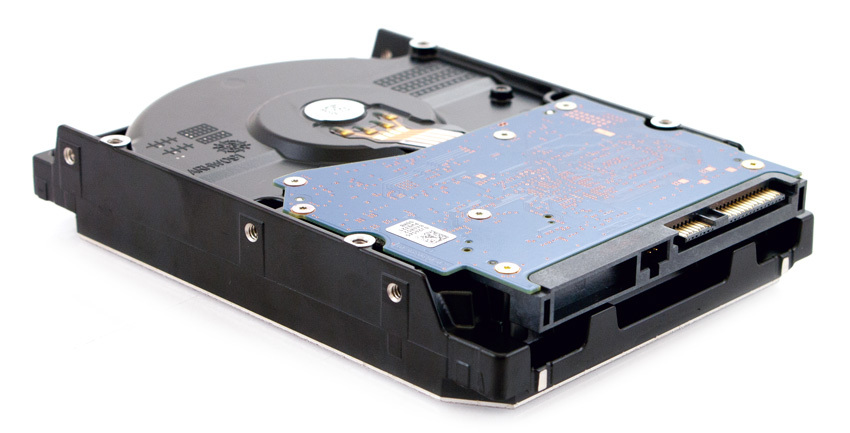
6TB helium drives come with SATA or SAS interfaces, this review will cover both types.
Models:
SAS: HUS726060ALS640 / 0F18370, HUS726060ALS641 / 0F20577
SATA: HUS726060ALA640 / 0F18335, HUS726060ALA641 / 0F20572
Interface: SAS 6Gb / s, SATA 6Gb / s
Capacity (GB): 6TB
The size of the sectoral (variable, byte / sector): 512/520/528 (SAS), 512n (SATA)
Maximum data density (gigabit / square inch): 544
Form Factor: 3.5 inch HDD
Performance:
- buffer size (MB): 64
- spindle speed (RPM): 7200
- maximum interface bandwidth (MB / s): 600
- linear speed (MB / s): 177
- search time (read, milliseconds): 8.5
Reliability:
- errors (with the impossibility of recovery, bits when reading): 1 out of 10 ^ 15
- MTBF (average time between errors, hours): 2.0
- number of rewrite cycles: 600,000
- warranty (years): 5
Noise Level (Bel): 2.0
Nutrition:
- requirements: +5 VDC (± 5%), + 12VDC (± 5%)
- initial current (A, maximum): 1.2 (+ 5V), 2.0 (+ 12V)
- read / write (W, average): 8.8 (SAS), 7.3 (SATA)
- active work (W average): 5.7 (SAS), 5.3 (SATA)
- standby mode (W): 4.1 (SAS), 3.7 (SATA)
Physical characteristics:
- Z-height (mm): 26.1
- measurements (width x depth, mm): 101.6 (± 0.25) x147
- weight (grams, maximum): 640
Environmental requirements during operation:
- ambient temperature: from 5º to 60ºC
- level of impacts (half sine wave): 70
- vibration (from 5 to 500Hz): 0.67 (XYZ)
Environmental requirements during storage:
- ambient temperature: -40º to 70ºC
- level of impacts (half sine wave): 300
- vibration (from 5 to 500Hz): 1.04 (XYZ)
As mentioned above, HGST created the first sealed disk filled with helium, thanks to which it was possible to significantly reduce energy consumption, to ensure greater density and reliability of data storage. On the front of the disc is a sticker with information about the disc, including the product name, capacity, and the HGST logo. Since the disk is filled with helium, its assembly is somewhat different - the components of the disk are merged together to keep helium inside.

Ultrastar He6 is much quieter than disks filled with air, while the noise level of the same Ultrastar 7K4000 is 2.9 Bel, the noise level for He6 is only 2 Bela. In addition, the disk consumes much less energy, tests carried out in real conditions give a value of 5.56 W, while for disks filled with air, this value is at the level of 7.68 W.
HGST was not able to provide the required number of hard drives to test application performance. If the situation changes in the future - these results will be added here.
SAS Enterprise HDD was compared to:
Seagate Constallation ES.3 4TB
Seagate Constallation ES.2 3TB
Toshiba 4TB SAS
Toshiba 3TB SAS
Hitachi 7K4000 4TB SAS
Go
SATA Enterprise HDD was compared to:
Western Digital RE4 4TB
Seagate Constellation ES.2 3TB
Seagate Constellation CS 3TB
Western Digital Se 4TB
Testing was conducted when loading up to 16 threads and 16 queues for each of the threads, which ensured the levels of light and heavy loads. Since hard drives reach their adjusted level of performance very quickly, we present a graph of only the main sections of each test.
Basic tests included testing:
- bandwidth (read + write, IOPS averaged);
- average delay (read + write, average total delay);
- maximum delay (when reading and writing);
- the standard deviation of the delay (averaged for reading and writing).
Performance was tested with blocks of different sizes - 4k for reading and writing, and 8K 70/30 for reading and writing, which is a common test for Enterprise-class drives:
- 4K (100% read or 100% write, 100% 4K);
- 8K 70/30 (70% read, 30% write, 100% 8K);
- 128K sequential (100% read or 100% write, 100% 128K).
In the first test, random performance was measured using 4k blocks for reading and writing to get a steady peak input / output (I / O), Ultrastar He6 SAS received an average reading result, slightly ahead of Seagate Constellation (4TB), While in terms of record, he was the last.
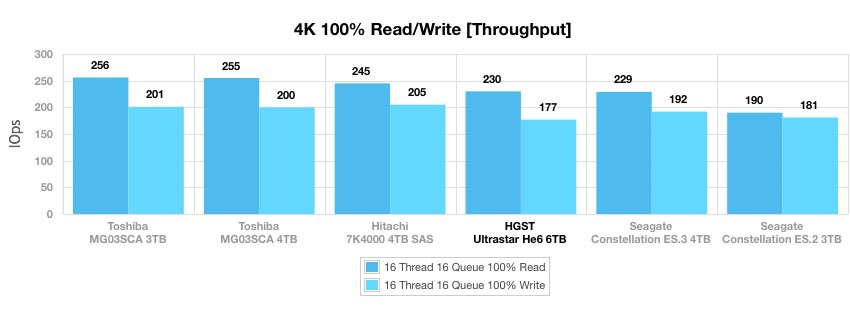
In the case of the SATA interface, Ultrastar He6 took the second place in terms of read speed, but it turned out to be practically the last in write performance, barely ahead of the Seagate Constellation 3TB.
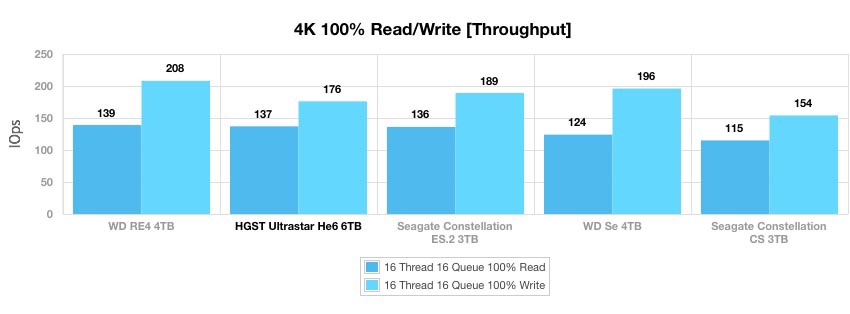
With a large queue load of 256 in our 4K random read and write test, the Ultrastar He6 SAS showed average read and write latencies at 1107.73 ms and 1442.20 ms, respectively.
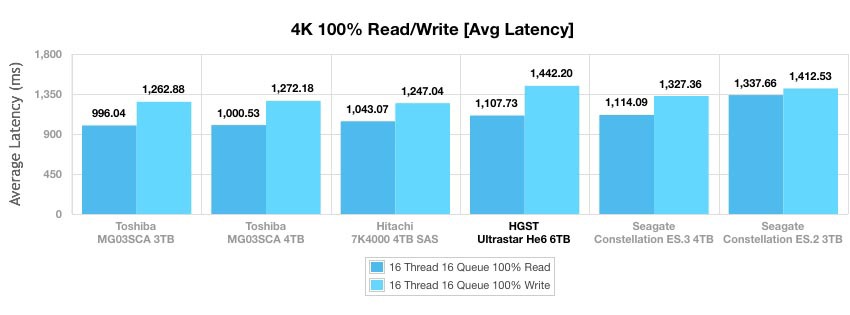
For the Ultrastar He6 SATA interface, the response values of 1850.92 ms for reading and 1,443.61 ms for writing were obtained, respectively.

By comparing the peak response times of SAS disks, the He6 SAS showed average values when reading and ranked last in the waiting time when writing by a wide margin.
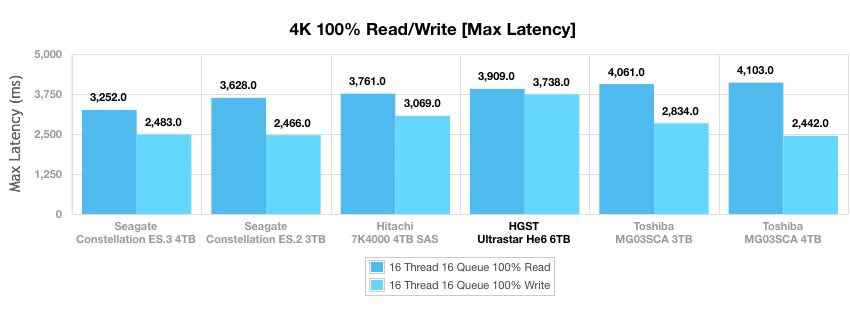
He6 with SATA interface in terms of latency when reading almost comes first, but on the last response when writing.
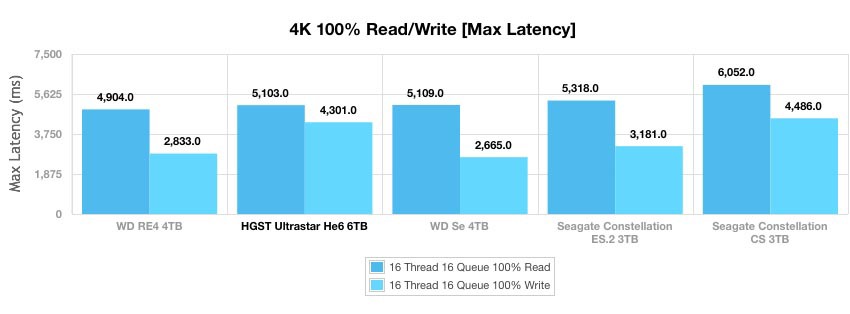
Considering the delays along with the measurements of the standard deviation, we get the result at which the He6 SAS comes in last place.
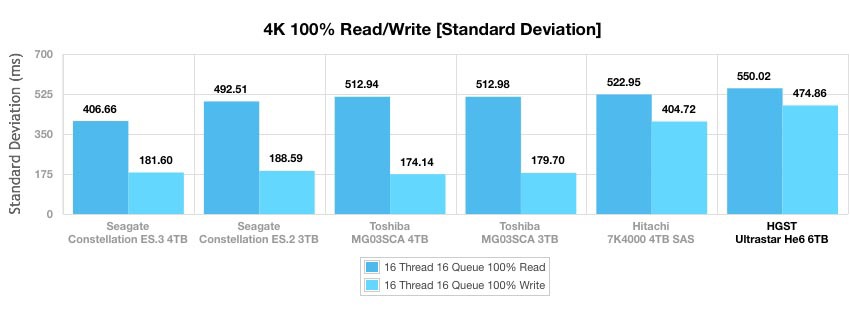
While He6 with SATA-interface takes a confident second place in the results when reading, but it turns out to be practically the last in the results of write operations.

Now consider the results of tests with variable load, where the load varies from 2 threads / 2 queues to 16 threads / 16 queues. In the 8k 70/30 test, the He6 SAS turned out to be practically the last, but much higher than the Seagate Constellation 3TB, which performance was consistently low from the very beginning, but stable, which is shown on the graph as a straight line.
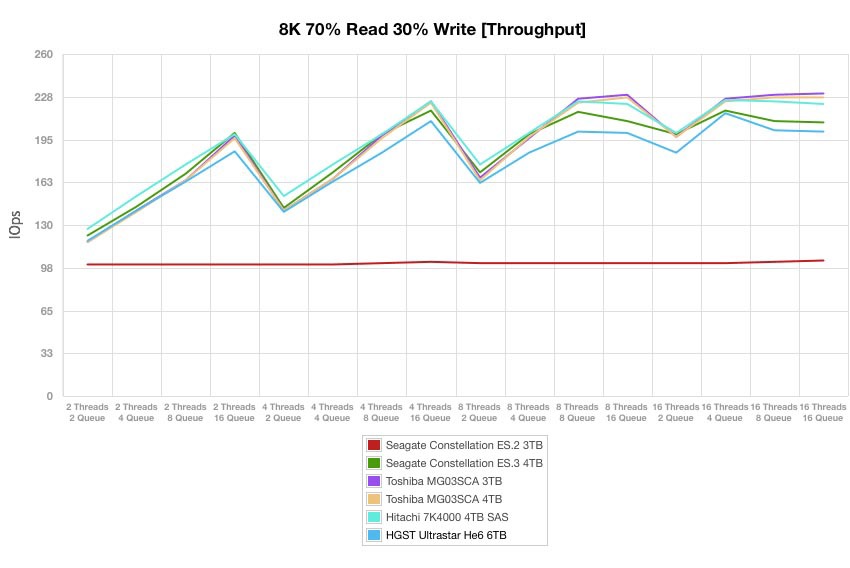
He6 with SATA-interface showed almost the best result, taking confidently the first place with a load of 16 threads / 16 queues, showing a value of 168 IOPS.
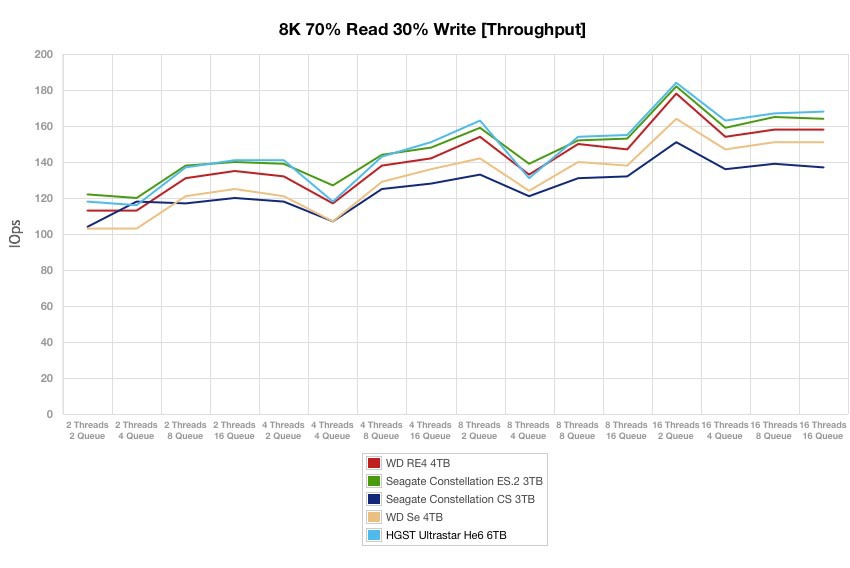
When measuring the average wait time for He6 SAS, we got a response time of 33.65 ms for 2 threads / 2 queues to 1266.53 ms for 16 threads / 16 queues.

Disk with SATA-interface showed the best result of an average response of 1516.51 ms for 16 threads / 16 queues.
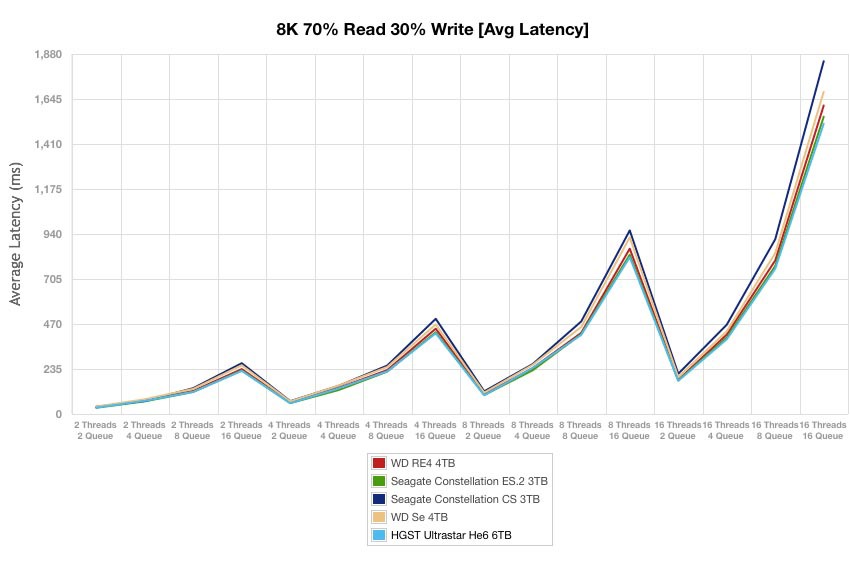
In the 8k 70/30 tests the maximum response of the He6 SAS showed almost the worst result, reaching a value of 3898.8 ms at the end of the test.
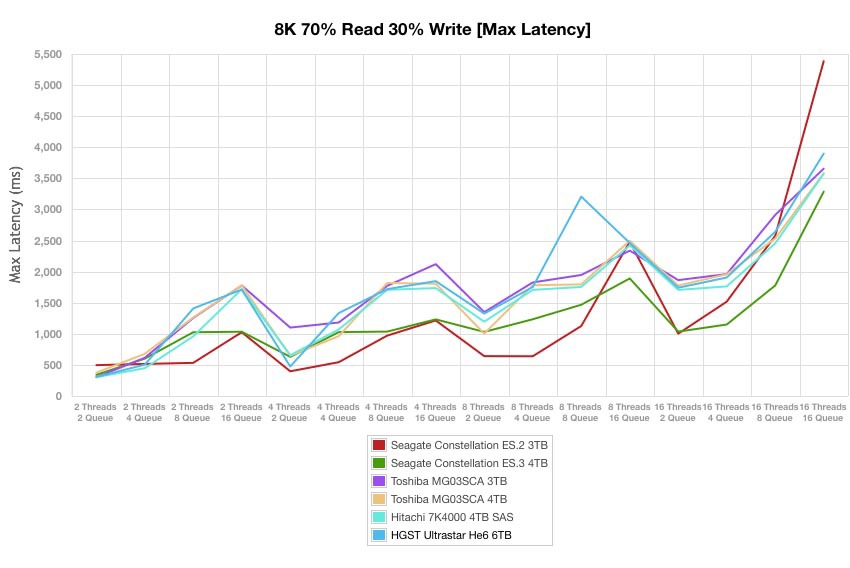
For a disk with a SATA interface, the situation is much better, since the minimum response time was 4,236.21 ms, which is hardly ahead of the value of the Seagate Constellation 3TB.
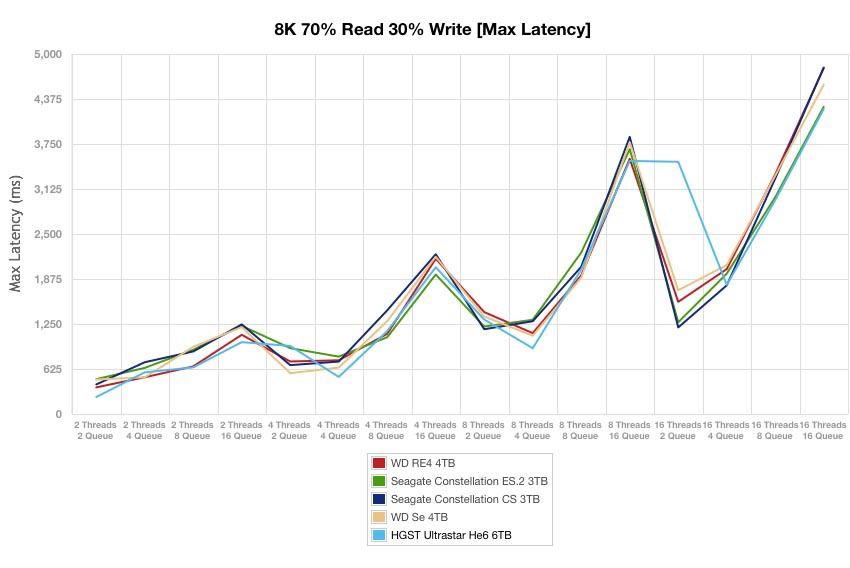
In the standard deviation test, the He6 SAS showed consistently the worst result at 629, 87 ms for 16 threads / 16 queues.

While He6 SATA shows the best values, taking the first place for the test with a load of 16 threads / 16 queues and demonstrating a value of 441.4 ms.
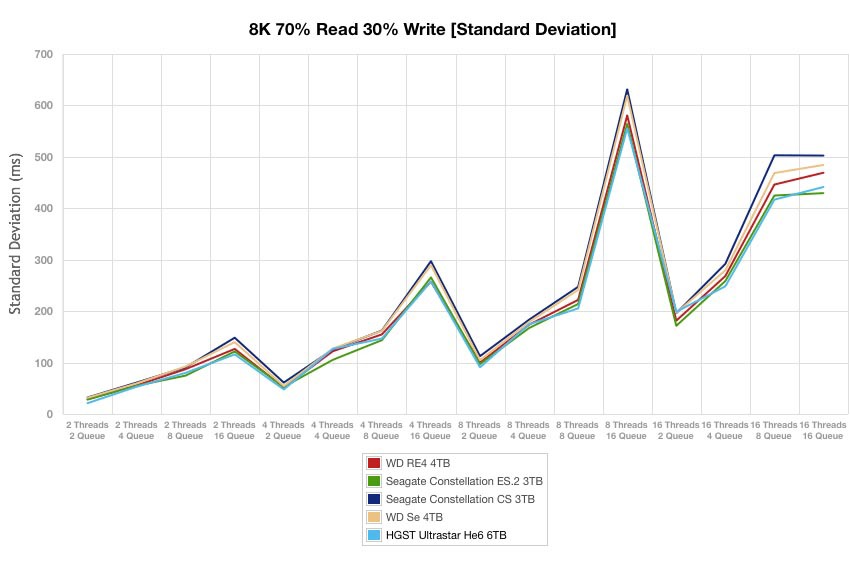
In the 128K sequential test, the He6 SAS showed amazing results in reading speed (184015 KB / s) and writing (183766 KB / s), confidently taking the first place.
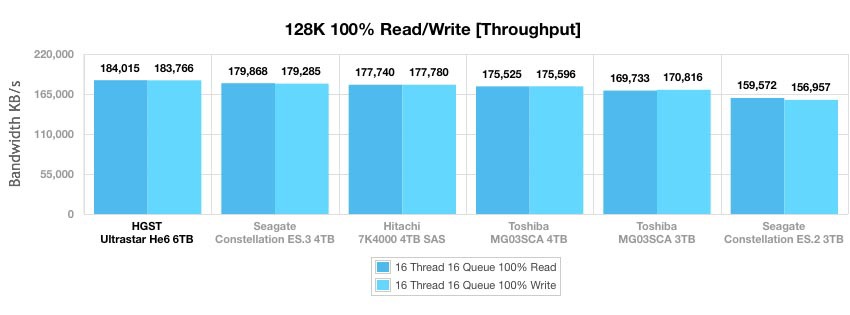
While He6 SATA was slightly worse, showing almost the same results as 182131 KB / s for reading and 182203 KB / s for writing.
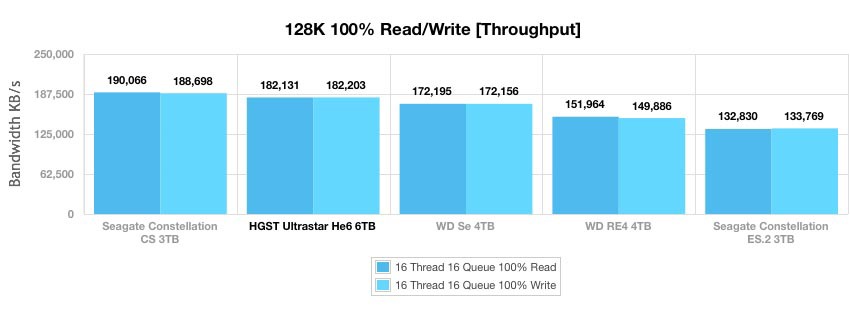
HGST Ultrastar He6 drives with SAS and SATA interfaces are a significant step toward increasing storage density and are ideal for enterprises that are experiencing an exponential growth in data because they provide 50% more storage capacity for data within existing infrastructure ( if 4TB disks were previously used), provide the possibility of using cooling systems in liquids, as they are hermetic, practically silent and very energy efficient.
- high storage density;
- almost the best performance for sequential reading and writing;
- low power consumption compared to traditional 7k 4TB discs.
- new technology, which so far does not have an extensive "track record";
- High initial price tag, which reached $ 850 before the announcement of the new series.
Of course, they are inferior in terms of performance when randomly reading and writing compared to other disks, but in spite of this it is difficult not to recommend these disks to those for whom data storage density and energy saving are more important.

The reduction in turbulence caused by the rotation of the plates allowed HGST to use seven plates in the traditional 3.5-inch form factor, as well as provide a speed of 177 MB / s for linear read / write operations. Apart from the fact that the HGST Ultrastar He6 drive is the world's first hard disk filled with helium, it is also the first 6 TB hard drive on the market. Its design provides an increase in power by 50% and still reduces the amount of energy required to start a disk to 23%.
')
In this article we will conduct a detailed analysis of the performance of this hard disk and consider the possible areas of its application.
Main characteristics:
- The most capacious HDD-drive on the market (6 TB, the design of the seven plates, providing the best total storage cost);
- minimum energy consumption with the best rate of W / TB (23% less power consumption in idle mode for each disk, 49% better than W / TB);
- The best recording density in the standard 3.5-inch form factor (50% increased capacity);
- weight is less than the standard 3.5-inch hard disk with five plates (50 g lighter even with two additional plates, while having 50% more capacity, 38% lower weight / TB).
Application environment:
- data centers with high density (the only cost-effective solution when using immersion cooling in mineral oil or fluid, since the disk is completely sealed and provides maximum data density);
- large horizontal scalable data centers;
- container data centers;
- semi-operational data storage systems;
- organization of mirror levels of data arrays;
- enterprises and data centers, where data density and storage capacity are of paramount importance.
For enterprises that are not in a hurry to upgrade their infrastructure, Ultrastar He6 is also a significant leap - without changing the platforms, you can increase the data storage density by 2-3 times, and you will be able to significantly save on electricity.

6TB helium drives come with SATA or SAS interfaces, this review will cover both types.
Detailed specifications
Models:
SAS: HUS726060ALS640 / 0F18370, HUS726060ALS641 / 0F20577
SATA: HUS726060ALA640 / 0F18335, HUS726060ALA641 / 0F20572
Interface: SAS 6Gb / s, SATA 6Gb / s
Capacity (GB): 6TB
The size of the sectoral (variable, byte / sector): 512/520/528 (SAS), 512n (SATA)
Maximum data density (gigabit / square inch): 544
Form Factor: 3.5 inch HDD
Performance:
- buffer size (MB): 64
- spindle speed (RPM): 7200
- maximum interface bandwidth (MB / s): 600
- linear speed (MB / s): 177
- search time (read, milliseconds): 8.5
Reliability:
- errors (with the impossibility of recovery, bits when reading): 1 out of 10 ^ 15
- MTBF (average time between errors, hours): 2.0
- number of rewrite cycles: 600,000
- warranty (years): 5
Noise Level (Bel): 2.0
Nutrition:
- requirements: +5 VDC (± 5%), + 12VDC (± 5%)
- initial current (A, maximum): 1.2 (+ 5V), 2.0 (+ 12V)
- read / write (W, average): 8.8 (SAS), 7.3 (SATA)
- active work (W average): 5.7 (SAS), 5.3 (SATA)
- standby mode (W): 4.1 (SAS), 3.7 (SATA)
Physical characteristics:
- Z-height (mm): 26.1
- measurements (width x depth, mm): 101.6 (± 0.25) x147
- weight (grams, maximum): 640
Environmental requirements during operation:
- ambient temperature: from 5º to 60ºC
- level of impacts (half sine wave): 70
- vibration (from 5 to 500Hz): 0.67 (XYZ)
Environmental requirements during storage:
- ambient temperature: -40º to 70ºC
- level of impacts (half sine wave): 300
- vibration (from 5 to 500Hz): 1.04 (XYZ)
Design and construction
As mentioned above, HGST created the first sealed disk filled with helium, thanks to which it was possible to significantly reduce energy consumption, to ensure greater density and reliability of data storage. On the front of the disc is a sticker with information about the disc, including the product name, capacity, and the HGST logo. Since the disk is filled with helium, its assembly is somewhat different - the components of the disk are merged together to keep helium inside.

Ultrastar He6 is much quieter than disks filled with air, while the noise level of the same Ultrastar 7K4000 is 2.9 Bel, the noise level for He6 is only 2 Bela. In addition, the disk consumes much less energy, tests carried out in real conditions give a value of 5.56 W, while for disks filled with air, this value is at the level of 7.68 W.
Application Performance Analysis
HGST was not able to provide the required number of hard drives to test application performance. If the situation changes in the future - these results will be added here.
Testing and Comparison
SAS Enterprise HDD was compared to:
Seagate Constallation ES.3 4TB
Seagate Constallation ES.2 3TB
Toshiba 4TB SAS
Toshiba 3TB SAS
Hitachi 7K4000 4TB SAS
Go
SATA Enterprise HDD was compared to:
Western Digital RE4 4TB
Seagate Constellation ES.2 3TB
Seagate Constellation CS 3TB
Western Digital Se 4TB
Testing was conducted when loading up to 16 threads and 16 queues for each of the threads, which ensured the levels of light and heavy loads. Since hard drives reach their adjusted level of performance very quickly, we present a graph of only the main sections of each test.
Basic tests included testing:
- bandwidth (read + write, IOPS averaged);
- average delay (read + write, average total delay);
- maximum delay (when reading and writing);
- the standard deviation of the delay (averaged for reading and writing).
Performance was tested with blocks of different sizes - 4k for reading and writing, and 8K 70/30 for reading and writing, which is a common test for Enterprise-class drives:
- 4K (100% read or 100% write, 100% 4K);
- 8K 70/30 (70% read, 30% write, 100% 8K);
- 128K sequential (100% read or 100% write, 100% 128K).
In the first test, random performance was measured using 4k blocks for reading and writing to get a steady peak input / output (I / O), Ultrastar He6 SAS received an average reading result, slightly ahead of Seagate Constellation (4TB), While in terms of record, he was the last.

In the case of the SATA interface, Ultrastar He6 took the second place in terms of read speed, but it turned out to be practically the last in write performance, barely ahead of the Seagate Constellation 3TB.

With a large queue load of 256 in our 4K random read and write test, the Ultrastar He6 SAS showed average read and write latencies at 1107.73 ms and 1442.20 ms, respectively.

For the Ultrastar He6 SATA interface, the response values of 1850.92 ms for reading and 1,443.61 ms for writing were obtained, respectively.

By comparing the peak response times of SAS disks, the He6 SAS showed average values when reading and ranked last in the waiting time when writing by a wide margin.

He6 with SATA interface in terms of latency when reading almost comes first, but on the last response when writing.

Considering the delays along with the measurements of the standard deviation, we get the result at which the He6 SAS comes in last place.

While He6 with SATA-interface takes a confident second place in the results when reading, but it turns out to be practically the last in the results of write operations.

Now consider the results of tests with variable load, where the load varies from 2 threads / 2 queues to 16 threads / 16 queues. In the 8k 70/30 test, the He6 SAS turned out to be practically the last, but much higher than the Seagate Constellation 3TB, which performance was consistently low from the very beginning, but stable, which is shown on the graph as a straight line.

He6 with SATA-interface showed almost the best result, taking confidently the first place with a load of 16 threads / 16 queues, showing a value of 168 IOPS.

When measuring the average wait time for He6 SAS, we got a response time of 33.65 ms for 2 threads / 2 queues to 1266.53 ms for 16 threads / 16 queues.

Disk with SATA-interface showed the best result of an average response of 1516.51 ms for 16 threads / 16 queues.

In the 8k 70/30 tests the maximum response of the He6 SAS showed almost the worst result, reaching a value of 3898.8 ms at the end of the test.

For a disk with a SATA interface, the situation is much better, since the minimum response time was 4,236.21 ms, which is hardly ahead of the value of the Seagate Constellation 3TB.

In the standard deviation test, the He6 SAS showed consistently the worst result at 629, 87 ms for 16 threads / 16 queues.

While He6 SATA shows the best values, taking the first place for the test with a load of 16 threads / 16 queues and demonstrating a value of 441.4 ms.

In the 128K sequential test, the He6 SAS showed amazing results in reading speed (184015 KB / s) and writing (183766 KB / s), confidently taking the first place.

While He6 SATA was slightly worse, showing almost the same results as 182131 KB / s for reading and 182203 KB / s for writing.

findings
HGST Ultrastar He6 drives with SAS and SATA interfaces are a significant step toward increasing storage density and are ideal for enterprises that are experiencing an exponential growth in data because they provide 50% more storage capacity for data within existing infrastructure ( if 4TB disks were previously used), provide the possibility of using cooling systems in liquids, as they are hermetic, practically silent and very energy efficient.
pros
- high storage density;
- almost the best performance for sequential reading and writing;
- low power consumption compared to traditional 7k 4TB discs.
Minuses
- new technology, which so far does not have an extensive "track record";
- High initial price tag, which reached $ 850 before the announcement of the new series.
Of course, they are inferior in terms of performance when randomly reading and writing compared to other disks, but in spite of this it is difficult not to recommend these disks to those for whom data storage density and energy saving are more important.
Source: https://habr.com/ru/post/243535/
All Articles